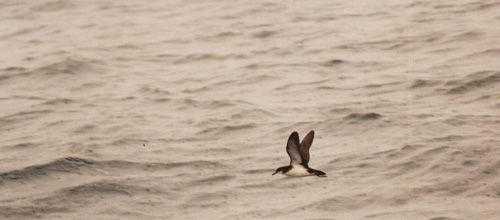
The Isles of Scilly is a place that strange people visit at this time of year in search of rare birds. Stuck 28 miles west of Lands End the islands reach out to the North American continent and provide a landfall for birds swept across the Atlantic on strong winds. However, there are, of course resident birds there too. Every year, Manx Shearwaters nest on the islands of St Agnes and Gugh because of the rich feeding areas surrounding these remote islands – and every year their eggs and chicks are eaten by introduced Brown Rats.
But this year, after an eradication programme, the islands are rat-free and the Manx Shearwaters have produced chicks that are now leaving their burrows and stargazing in the evenings in preparation for setting off on their first flights which will take them to the waters off Argentina until they return to breed themselves in a few years’ time.
Brown Rats probably arrived on the islands from seventeenth century shipwrecks and every year since then they have been nibbling and chewing their way through the ground-nesting seabirds. Manx Shearwaters nest in burrows and are easy prey to non-native ground predators – they usually nest on predator-free islands. The UK holds around 80% of the world population of this species with Scotland (especially the island of Rhum) and Wales (especially the Pembrokeshire islands of Skokholm and Skomer) holding the biggest colonies. There was once a vast colony on the Isle of Man (thus, the species’ name) but that was eradicated by introduced Brown Rats (from shipwrecks) in the late eighteenth century.
The chicks are left in their burrows by their parents and spend some time coming to the burrow entrances at night to stretch their wings and to get their bearings by memorising the star patterns in the night sky.
Isles of Scilly Seabird Project Ecologist Vickie Heaney said: “For so many years now I’ve been returning to the burrows looking for evidence of chicks fledging, only to find old cobwebs over the entrances and no signs of life. So it’s been really brilliant this year for myself, project staff and volunteers to see live chicks stargazing. With their remnants of fluff, they looked fit and healthy; ready for their awe-inspiring migration.”
David Appleton, adviser for the Isles of Scilly Seabird Recovery Project’ for Natural England, said: “This is excellent news – it’s early stages but we are very hopeful about the bird’s recovery on St Agnes and Gugh. We’ll know more when they return to breed in 2 to 4 years. In the meantime, everyone is working hard to keep rats off the islands and we’re asking residents and visitors to report any rat sightings to the hotline number and to thoroughly check for “stowaways” on transport to the islands.”
RSPB Project Manager, Jaclyn Pearson said: “We are absolutely delighted to announce this news. It is down to the help of everyone involved in the project so far, particularly the community living on the islands who continue to keep these islands rat –free. This is an official status we hope to achieve by early 2016. But in the meantime with these 10 Manx shearwater chicks, the project is having exactly the effect we hoped for. We would also thank our funders LIFE, and the Heritage Lottery Fund for making this work possible.”
If people think they see rats on either St Agnes or Gugh they are asked to call the project ‘Rat on a rat’ hot-line on 01720 422153. The project team and islanders will then inspect the area and set up surveillance and incursion response measures.
[registration_form]
Great news. Rats (and cats) are a disaster on islands. Let’s hope other sites can be identified and restored
Sometimes it seems that there is only bad news so stories such as this one and the recent spoon-billed sandpiper post provide a nice antidote to that. Very uplifting! Well done to everyone involved in this project.
Absolutely fantastic!